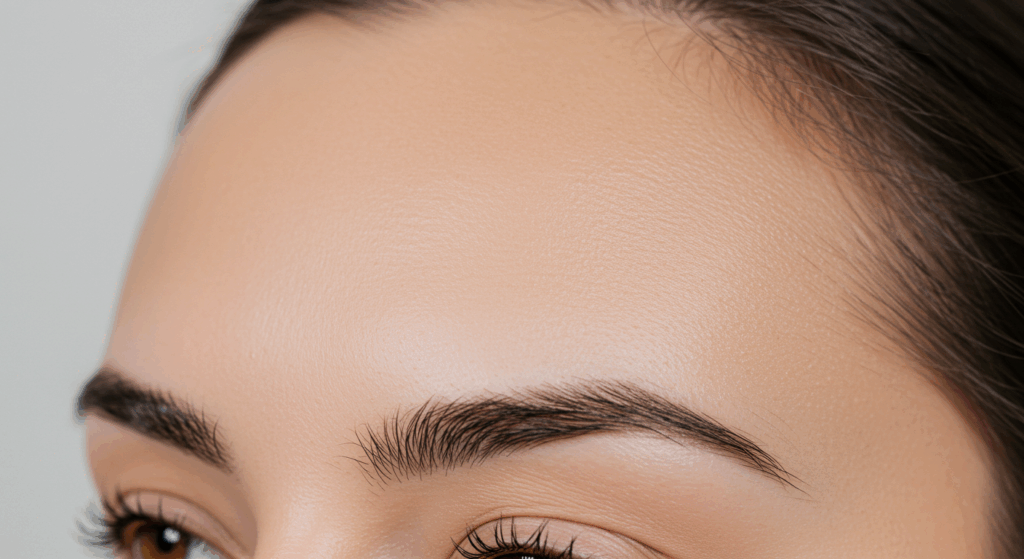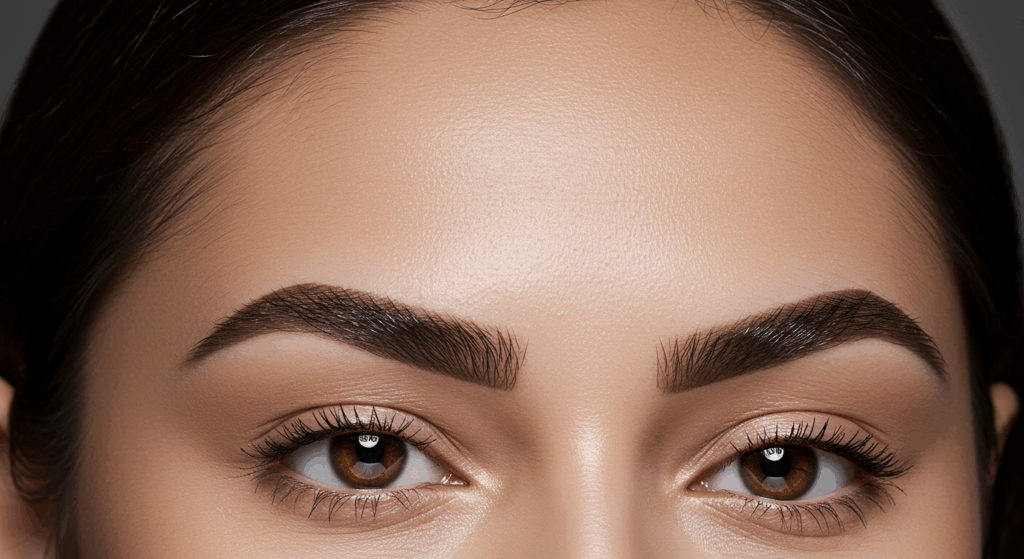For transgender women (MTF) seeking facial feminization surgery (FFS), achieving a softer and more feminine brow and upper orbital region is often a key objective. The supraorbital rims, the bony arches located above the eye sockets, play a significant role in the perceived masculinity or femininity of the upper face. Masculine supraorbital rims tend to be more prominent, angular, and project forward more noticeably than their feminine counterparts, which are typically smoother, less defined, and blend more seamlessly with the forehead.
Supraorbital rim reduction is a surgical procedure designed to address these bony differences, contributing significantly to overall facial feminization. This comprehensive guide, written from a surgeon’s perspective, delves into the intricacies of supraorbital rim reduction, explaining the anatomical considerations, surgical techniques, and expected outcomes in detail.

Table of Contents
Understanding the Supraorbital Rim and its Role in Facial Gender
The supraorbital rim is the bony edge of the frontal bone that forms the upper border of the eye socket (orbit). Its shape and projection are crucial in defining the contour of the brow and the transition between the forehead and the eyes.
Anatomical Differences Between Male and Female Supraorbital Rims
- Projection: Male supraorbital rims often exhibit a more pronounced anterior (forward) projection, creating a noticeable “shelf” or ridge above the eyes. This is often associated with a more prominent frontal sinus located beneath this bony prominence.
- Angularity: Masculine brow bones tend to be more angular and less curved than feminine ones. The lateral (outer) aspect of the male supraorbital rim can be particularly sharp or defined.
- Smoothness: Feminine supraorbital rims typically have a smoother, more continuous contour that blends gently with the forehead without a distinct ridge.
The Influence of Supraorbital Rims on Facial Perception
The prominence and shape of the supraorbital rims significantly contribute to the overall masculine appearance of the upper face. Reducing this prominence and creating a smoother contour can have a profound feminizing effect, softening the brow area and making the eyes appear more open and feminine.
Hormonal Influence on Supraorbital Rims
It is crucial to understand that while hormone replacement therapy (HRT) induces significant changes in soft tissues, it has minimal impact on the underlying bony structure of the skull, including the supraorbital rims, in adults. Therefore, surgical intervention is typically necessary to achieve a noticeable and lasting reduction in the prominence of the brow bones.
Surgical Techniques for Supraorbital Rim Reduction
Several surgical techniques can be employed to reduce the prominence and feminize the contour of the supraorbital rims. The specific approach depends on the individual’s anatomy, the degree of reduction desired, and whether the prominence is primarily due to the bone itself or the underlying frontal sinus.
Direct Bone Burring (Osteoplasty)
- Technical Explanation: For individuals with mild prominence of the supraorbital rims where the projection is primarily due to the thickness of the bone itself and the frontal sinus does not significantly contribute, direct bone burring (osteoplasty) can be an effective technique. This involves using high-speed surgical burs (rotating instruments with abrasive surfaces) to carefully shave down and smooth the outer layer of the bone, reducing its projection and angularity.
- Colloquial Explanation: Imagine using a specialized sanding tool to gently file down the prominent and sharp edges of the bone above your eyes, making them smoother and less protruding.
- Ideal Candidates: Those with relatively thin brow bones and minimal frontal sinus projection.
- Limitations: The amount of bone that can be safely removed is limited by the proximity to the frontal sinus and the need to maintain structural integrity.
Anterior Table Setback (Cranioplasty with Bone Remodeling)
- Technical Explanation: When the prominence of the supraorbital rims is significantly influenced by the projection of the anterior table (outer layer) of the frontal bone overlying the frontal sinus, a more involved technique called anterior table setback may be necessary. This is often performed as part of a Type 2 or Type 3 foreheadplasty. The procedure involves:
- Exposure: A coronal incision (across the scalp behind the hairline) is made to expose the frontal bone and supraorbital rims.
- Osteotomy: A precise cut (osteotomy) is made in the frontal bone anterior to the frontal sinus.
- Anterior Table Elevation and Reshaping: The anterior table of the frontal bone, which forms the prominent brow ridge, is carefully elevated. It can then be thinned, contoured, or even partially removed and reshaped to reduce its projection and angularity.
- Setback and Fixation: The reshaped anterior table is then set back (moved posteriorly) to create a smoother transition from the forehead to the eyes. It is secured in its new position using small titanium plates and screws.
- Supraorbital Rim Contouring: The exposed bony edges of the supraorbital rims can be further contoured by burring to refine their shape and smoothness.
- Colloquial Explanation: Imagine the bone above your eyes has an outer “shell” that’s sticking out too much because of an air pocket (frontal sinus) underneath. The surgeon carefully removes this outer shell, reshapes it to be flatter and less angular, and then puts it back in a more recessed position, essentially pushing it inwards. They also smooth down any remaining sharp edges of the bone.
- Ideal Candidates: Individuals with more significant brow bossing due to frontal sinus projection and angular supraorbital rims.
- Advantages: Allows for a more substantial reduction in brow bone prominence and more comprehensive contouring of the supraorbital rims.
Subcutaneous Fat Grafting to the Forehead and Brow
- Technical Explanation: While not a direct reduction of the bony supraorbital rims, the injection of autologous (from the patient’s own body) fat into the subcutaneous tissue of the forehead and brow area can help to soften the contours of the underlying bone. Liposuction is used to harvest fat from other areas of the body (e.g., abdomen, thighs), which is then processed and injected into the desired areas.
- Colloquial Explanation: Think of using soft filler (your own fat) to gently fill in the areas around the bony brow ridge, making the transition to the forehead smoother and less sharp.
- Ideal Candidates: Individuals who desire a subtle softening of the brow contours and may not require or be candidates for significant bony reduction. This can also complement bony reduction procedures.
- Limitations: The amount of fat that can be grafted is limited, and some of the injected fat may be reabsorbed over time. Multiple sessions may be needed. This technique primarily addresses the soft tissue appearance rather than directly altering the bone.
Combination Approaches
Often, a combination of these techniques is used to achieve the desired feminine brow contour. For example, a patient might undergo anterior table setback to address significant brow bossing, followed by direct bone burring to refine the edges of the supraorbital rims and fat grafting to further soften the transition to the forehead.

The Surgical Process: From Consultation to Recovery for Supraorbital Rim Reduction
Undergoing supraorbital rim reduction surgery involves a similar multi-stage process as other facial feminization procedures.
Initial Consultation and Assessment
A thorough consultation with a board-certified plastic surgeon experienced in facial feminization is crucial. The surgeon will:
- Review your medical history: To identify any contraindications or risk factors.
- Understand your goals and expectations: To determine your desired brow contour and discuss the feasibility of achieving it through surgery.
- Perform a detailed facial analysis: Assessing your brow bone prominence, forehead shape, and overall facial harmony. This may involve physical examination and review of 3D CT scans.
- Explain the different surgical options: Discussing the most suitable techniques based on your individual anatomy and goals.
- **Outline the risks, benefits, and limitations of the procedure.
- Provide information about the anesthesia, surgical facility, and cost.
Pre-Operative Preparation
Following the consultation, you will receive detailed pre-operative instructions, which may include:
- Optimizing your health: This may involve quitting smoking and managing any underlying medical conditions.
- Avoiding certain medications: Such as blood thinners and non-steroidal anti-inflammatory drugs (NSAIDs) for a specified period before surgery.
- Undergoing pre-operative medical tests: To ensure you are fit for surgery.
- Arranging for transportation and post-operative care.
The Surgical Procedure
Supraorbital rim reduction is typically performed under general anesthesia. The specific steps depend on the chosen technique.
- Incision: A coronal incision is the most common approach for open bony reduction techniques, providing excellent access to the frontal bone and supraorbital rims.
- Exposure of the Bone: The scalp and soft tissues are carefully elevated to expose the frontal bone and the supraorbital rims.
- Bone Reshaping: Depending on the technique, this involves burring, osteotomies, bone removal, and setback of the anterior table.
- Fixation (if applicable): Repositioned bone segments are secured with small titanium plates and screws.
- Fat Grafting (if applicable): Harvested and processed fat is injected into the subcutaneous tissues of the forehead and brow.
- Closure: The scalp incision is closed in layers with sutures or surgical staples.
Post-Operative Recovery
Recovery after supraorbital rim reduction involves swelling, bruising, and discomfort.
- Immediate Post-Op: Expect swelling and bruising around the forehead and eyes. Pain medication will be prescribed. A compression dressing may be applied.
- First Few Weeks: Swelling and bruising will gradually subside. Sutures or staples are typically removed within 7-14 days. Avoid strenuous activity and heavy lifting. Keep the head elevated. Numbness or tingling in the scalp is common.
- Mid-Term Recovery (Weeks to Months): Residual swelling may persist for several months. The final contour of the brow will become more apparent as the swelling resolves. Numbness usually improves gradually.
- Long-Term Recovery (Months to a Year): The tissues will continue to settle, and any scars will mature and fade over time. The titanium plates and screws typically remain in place without causing issues.
Potential Risks and Complications of Supraorbital Rim Reduction
- Infection: Although rare with proper surgical technique and post-operative care.
- Bleeding and Hematoma: Collection of blood under the skin requiring drainage.
- Nerve Damage: Potential for temporary or permanent numbness or weakness in the forehead, scalp, or around the eyes (e.g., affecting eyebrow movement).
- Scalp Necrosis or Hair Loss: Rare but possible, especially with extensive scalp elevation.
- Frontal Sinus Injury or Infection (Sinusitis): More common with techniques involving the frontal sinus.
- Asymmetry: Despite meticulous planning, some degree of asymmetry can occur.
- Plate Palpability: The titanium plates used for fixation may be felt under the skin in thin individuals.
- Unsatisfactory Aesthetic Outcome: The final brow contour may not fully meet the patient’s expectations, potentially requiring revision surgery.
Choosing an experienced and highly skilled facial feminization surgeon is crucial to minimize these risks and optimize outcomes.
The Role of Supraorbital Rim Reduction in Comprehensive Facial Feminization
Supraorbital rim reduction is a significant component of facial feminization surgery, often performed in conjunction with other procedures such as foreheadplasty (to address the overall forehead shape and brow bossing), rhinoplasty (nose reshaping), and jaw and chin contouring to achieve a harmonious and feminine facial appearance. Feminizing the brow and upper orbital region can have a profound impact on the overall perception of gender.

Conclusion: Achieving Feminine Brow Contours
Supraorbital rim reduction is a specialized surgical procedure that plays a crucial role in feminizing the upper face for MTF individuals. By addressing the bony prominence and angularity of the brow bones, surgeons can create a smoother, more feminine contour that harmonizes with other facial features.
Understanding the different surgical techniques available, the surgical process, and the potential risks and benefits is essential for individuals considering this procedure. Choosing a board-certified facial feminization surgeon with extensive experience in supraorbital rim reduction is paramount for a safe and successful journey towards a more authentic and affirmed facial identity. This targeted approach to brow contouring represents a vital step in the broader process of gender transition and self-discovery, contributing significantly to increased self-confidence and well-being.
Visit Dr.MFO Instagram profile to see real patient transformations! Get a glimpse of the incredible results achieved through facial feminization surgery and other procedures. The profile showcases before-and-after photos that highlight Dr. MFO’s expertise and artistic vision in creating natural-looking, beautiful outcomes.
Ready to take the next step in your journey? Schedule a free consultation with Dr. MFO ( Best Facial Feminization Surgeon for You) today. During the consultation, you can discuss your goals, ask any questions you may have, and learn more about how Dr. MFO can help you achieve your desired look. Don’t hesitate to take advantage of this free opportunity to explore your options and see if Dr. MFO is the right fit for you.









